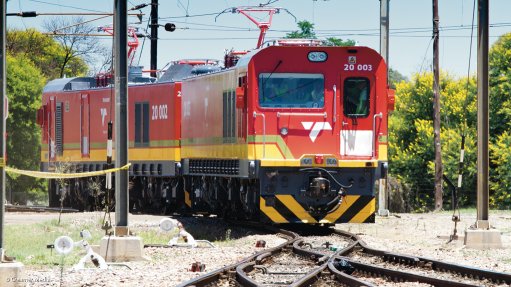Solar energy plant on the way at vanadium operation, Glencore’s Fullard reports




Glencore Alloys head Japie Fullard.
Glencore Industrial Assets head Peter Freyberg.
Glencore CEO Gary Nagle.
The decarbonisation and solar power plans of Glencore Alloys are coming to the fore with the first 25 MW solar plant on the way, Glencore Alloys head Japie Fullard told Engineering News & Mining Weekly at question time during a media call earlier this month.
“We’ve got all our approvals in place so we will be starting to build that at the Rhovan vanadium operation,” Fullard said.
Rhovan is situated about 30 km to the north-west of Brits, in South Africa’s North West province.
On Glencore Alloys’ other renewable energy projects, Fullard said that as part of a virtual power purchase agreement process, the company is working with two independent power producers (IPPs) where the company will be receiving wheeled energy.
“With one of our IPPs, we’re about 95% complete and with the other about 40% complete. On the one IPP, we’re talking about 200 MW and on the other 150 MW solar. It’s quite substantial,” Fullard added.
Glencore Alloys produces and markets chrome ore, ferrochrome and vanadium, as well as manganese ore and alloys.
Forming part of Glencore Alloys’ decarbonisation commitments are potential on-site projects involving possible cogeneration, which involves turning currently wasted operational offgas into electricity.
Elaborating on the company’s overall decarbonisation implementation, Glencore Industrial Assets head Peter Freyberg described Fullard’s South African ferroalloys team as the poster boys for getting things done on the decarbonisation front, driven by necessity.
The London- and Johannesburg-listed company, which set a short-term target of a 15% reduction in total Scope 1, 2 and 3 emissions by 2026, is on track to achieve those targets, and has works in place to achieve what it is saying it needs to do by 2035.
“We’ve got a broad range of initiatives worldwide, the main ones right now being focused on Scope 2 emissions, which are one-third of our Scope 1 emissions, and are probably the quickest that we can do to switch from carbon-intensive electricity that we’re buying around the world, to renewables. This is happening whether it’s in South America, Australia, Europe or wherever, and making sure that we take this initiative early and lock in those reductions.
“In terms of Scope 1, we’re also doing a lot of work around waste heat and the electrification of mining fleets. We expect in the next 18 months or so to be running trials. We’re looking at fuel switching where that’s possible and also, where feasible – and this is going back to Scope 2 – we have solar projects worldwide,” said Freyberg, who added that in South Africa, there are a wide range of initiatives within Astron Energy to make that refinery more efficient and reduce its carbon.
Regarding the extent to which the winddown of South Africa’s coal operations will be balanced by participation in the Just Energy Transition, Glencore Coal CEO Murray Houston said: “Our amount of assets and our life-of-mine long-term planning to 2026, 2035 and ultimately 2050 strategy fits very well within the early stages of the Just Energy Transition.
“We’re engaged by the coal leadership forum at Minerals Council South Africa on this transition because it’s going to be a huge focus regionally on the Highveld, and a massive challenge with that concentration of economic activity there. “Along with the coal industry, it’s also hugely important that Eskom’s part of that, but also key players in the Highveld area like Transnet and Sasol.
“It’s relatively early days of this holistic engagement and the intensity is still evolving but that’s the picture in terms of how we see our business fitting in with that country transition,” said Houston.
On Glencore’s vision for petroleum supplier company Astron, Glencore CEO Gary Nagle said: “Astron is up and running. We’ve got a terrific management team that has done a terrific job in rebuilding the refinery, and motivating the team.”
The refinery is operating at full capacity in processing over 90 000 bbl/d as one of only two crude oil refineries operating in South Africa, the other being Natref. The others are closed, with Secunda’s coal-to-liquids operation being a different kind of refinery.
On Astron’s beneficiation prowess, Nagle said: “We’re big believers and promoters of local beneficiation and this is exactly what the refinery is. It’s local beneficiation and we’re hopeful that it remains competitive with international imports.
“We’re obviously hoping for a favourable carbon tax and other regulatory environment to ensure that beneficiating in South Africa remains profitable and something that we will do because it’s something that we're very much in favour of. It’s a very good business, refining margins are strong at the moment, and we’re very dedicated to that business. It helps our oil marketing business as well and we supply a full range of various crude oils into that refinery for processing,” Nagle added.
Crude oil arrives by oil tanker in Saldanha Bay for discharge and is then transported to the Cape Town refinery by pipeline. The Astron team is then responsible for converting the crude oil into final products, including liquefied petroleum gas (LPG), petrol, jet fuel, diesel and fuel oil.
The refining process starts in the distillation towers, where crude oil is separated into various components. These components are then further processed and treated to produce final products. Some of the processes used at the refinery are hydrotreating, cracking and reforming.
The refinery also uses processes to remove impurities in the component streams, the most significant of these impurities being sulphur.
A significant portion of the components separated from the crude oil need to be further processed using catalysts to convert low-value product to high value product. Some of the process units used at the refinery are:
- • a fluidised catalytic cracking unit, which cracks the heavy product into LPG, petrol and diesel; and
- • platformer and Isom units that convert low-octane petrol components to high- octane petrol.
The final products are blended from the various treated component streams and are stored in tanks, ready to be shipped by tanker, truck or pipeline to customers throughout South Africa.
“We’ve rebranded one of the largest existing forecourt networks and reimagined a fuel brand,” Astron states on its website.
Comments
Press Office
Announcements
What's On
Subscribe to improve your user experience...
Option 1 (equivalent of R125 a month):
Receive a weekly copy of Creamer Media's Engineering News & Mining Weekly magazine
(print copy for those in South Africa and e-magazine for those outside of South Africa)
Receive daily email newsletters
Access to full search results
Access archive of magazine back copies
Access to Projects in Progress
Access to ONE Research Report of your choice in PDF format
Option 2 (equivalent of R375 a month):
All benefits from Option 1
PLUS
Access to Creamer Media's Research Channel Africa for ALL Research Reports, in PDF format, on various industrial and mining sectors
including Electricity; Water; Energy Transition; Hydrogen; Roads, Rail and Ports; Coal; Gold; Platinum; Battery Metals; etc.
Already a subscriber?
Forgotten your password?
Receive weekly copy of Creamer Media's Engineering News & Mining Weekly magazine (print copy for those in South Africa and e-magazine for those outside of South Africa)
➕
Recieve daily email newsletters
➕
Access to full search results
➕
Access archive of magazine back copies
➕
Access to Projects in Progress
➕
Access to ONE Research Report of your choice in PDF format
RESEARCH CHANNEL AFRICA
R4500 (equivalent of R375 a month)
SUBSCRIBEAll benefits from Option 1
➕
Access to Creamer Media's Research Channel Africa for ALL Research Reports on various industrial and mining sectors, in PDF format, including on:
Electricity
➕
Water
➕
Energy Transition
➕
Hydrogen
➕
Roads, Rail and Ports
➕
Coal
➕
Gold
➕
Platinum
➕
Battery Metals
➕
etc.
Receive all benefits from Option 1 or Option 2 delivered to numerous people at your company
➕
Multiple User names and Passwords for simultaneous log-ins
➕
Intranet integration access to all in your organisation

















